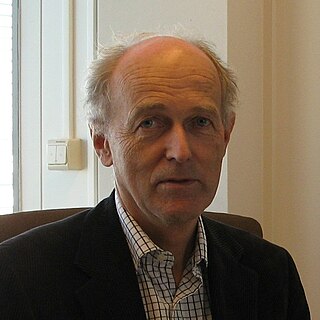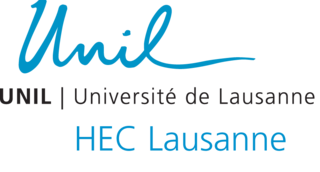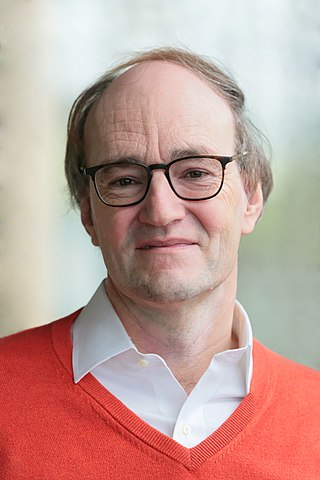
Alexander Osterwalder (born 1974) is a Swiss business theorist, [1] author, speaker, consultant, and entrepreneur, known for his work on business modeling [2] and the development of the Business Model Canvas. [3]

Alexander Osterwalder (born 1974) is a Swiss business theorist, [1] author, speaker, consultant, and entrepreneur, known for his work on business modeling [2] and the development of the Business Model Canvas. [3]
Born 1974 in St. Gallen, [4] Osterwalder obtained his MA in Political Science in 2000 at the University of Lausanne, where in 2004 he also obtained his PhD in Management Information Systems [5] under Yves Pigneur with the thesis, entitled "The Business Model Ontology - a proposition in a design science approach."
In 1999 Osterwalder co-founded his first startup Netfinance.ch, which focused on financial literacy. He was a journalist for the Swiss business magazine BILANZ in 2000–01, and Senior Research Fellow back at the University of Lausanne from 2000 to 2005 in the time he finished his PhD research. In 2006 he founded BusinessModelDesign.com, and in 2010 he co-founded the consultancy firm Strategyzer, which has provided over 5 million people with Osterwalder's Business Model Canvas.
In the late 2000s Osterwalder and a team of 470 co-creators published a model for describing business models: the Business Model Canvas. The Business Model Canvas seeks to offer a model to further develop ideas about the business model for monetizing data. [1]
Articles, a selection:
In computer science and information science, an ontology encompasses a representation, formal naming, and definition of the categories, properties, and relations between the concepts, data, and entities that substantiate one, many, or all domains of discourse. More simply, an ontology is a way of showing the properties of a subject area and how they are related, by defining a set of concepts and categories that represent the subject.

A business model describes how an organization creates, delivers, and captures value, in economic, social, cultural or other contexts. The process of business model construction and modification is also called business model innovation and forms a part of business strategy.
A concept of design science was introduced in 1957 by R. Buckminster Fuller who defined it as a systematic form of designing. He expanded on this concept in his World Design Science Decade proposal to the International Union of Architects in 1961. The term was later used by S. A. Gregory in the 1965 'The Design Method' Conference where he drew the distinction between scientific method and design method. Gregory was clear in his view that design was not a science and that design science referred to the scientific study of design. Herbert Simon in his 1968 Karl Taylor Compton lectures used and popularized these terms in his argument for the scientific study of the artificial. Over the intervening period the two uses of the term have co-mingled to the point where design science may have both meanings: a science of design and design as a science.

Barry Smith is an academic working in the fields of ontology and biomedical informatics. Smith is the author of more than 700 scientific publications, including 15 authored or edited books, and he is one of the most widely cited living philosophers.
Ralph Kimball is an author on the subject of data warehousing and business intelligence. He is one of the original architects of data warehousing and is known for long-term convictions that data warehouses must be designed to be understandable and fast. His bottom-up methodology, also known as dimensional modeling or the Kimball methodology, is one of the two main data warehousing methodologies alongside Bill Inmon.

Jean Leonardus Gerardus (Jan) Dietz is a Dutch Information systems researcher, Emeritus Professor of Information Systems Design, and part-time Professor of Enterprise Engineering at the Delft University of Technology, known for the development of the Design & Engineering Methodology for Organizations. and his work on enterprise ontology.

HEC Lausanne, also called the Faculty of Business and Economics of the University of Lausanne, is the affiliated business school of the University of Lausanne. Since 1911, HEC Lausanne has been developing teaching and research in the field of business and economics. The school is considered one of the best business schools in Switzerland. HEC Lausanne offers Bachelor, Master, and PhD degrees, as well as executive education, including a part-time Executive MBA, short, open courses, and tailor-made programs for organizations.
The Triune Continuum Paradigm is a paradigm for general system modeling published in 2002. The paradigm allows for building of rigorous conceptual frameworks employed for systems modeling in various application contexts.
Alain Wegmann was a Swiss computer scientist, professor of Systemic Modeling at the École Polytechnique Fédérale de Lausanne (EPFL), and Information Technology and Services consultant, known for the development of the Systemic Enterprise Architecture Methodology (SEAM).
A minimum viable product (MVP) is a version of a product with just enough features to be usable by early customers who can then provide feedback for future product development.
Lean startup is a methodology for developing businesses and products that aims to shorten product development cycles and rapidly discover if a proposed business model is viable; this is achieved by adopting a combination of business-hypothesis-driven experimentation, iterative product releases, and validated learning. Lean startup emphasizes customer feedback over intuition and flexibility over planning. This methodology enables recovery from failures more often than traditional ways of product development.
Gábor Laurenczy is a Hungarian chemist and academic. He currently heads the Group of Catalysis for Energy and Environment of the École Polytechnique Fédérale de Lausanne.
Business model patterns are reusable business model architectural components, which can be used in generating a new business model. In the process of new business model generation, the business model innovator can use one or more of these patterns to creating a new business model. Each of these patterns has similarities in characteristics, business model building blocks arrangements and behaviors. Alexander Osterwalder call these similarities the "business model pattern".
"Innovation, entrepreneurship and disruption are not about creative genius",

Michael Gruninger is a Canadian computer scientist and Professor of Industrial Engineering at the University of Toronto, known for his work on Ontologies in information science. particularly with the Process Specification Language, and in enterprise modelling on the TOVE Project with Mark S. Fox.
Yves Pigneur is a Belgian computer scientist, and Professor of Management Information Systems at the University of Lausanne since 1984, known for his work on the business model canvas with Alexander Osterwalder. He is considered a "mastermind" among business strategics, his canvas have been used by numerous companies such as P&G, Amazon, Lockheed Martin and Tesla.

The Business Model Canvas is a strategic management template used for developing new business models and documenting existing ones. It offers a visual chart with elements describing a firm's or product's value proposition, infrastructure, customers, and finances, assisting businesses to align their activities by illustrating potential trade-offs.
Customer development is a formal methodology for building startups and new corporate ventures. It is one of the three parts that make up a lean startup.

Boi Volkert Faltings is a Swiss professor of artificial intelligence at École Polytechnique Fédérale de Lausanne.
Catherine J. "Cathy" Price is a British neuroscientist and academic. She is a professor of cognitive neuroscience and director of the Wellcome Trust Centre for Neuroimaging at University College London.

The Platform Canvas is a conceptual framework dedicated to explain the mechanisms of multi-sided platform organizations, and how value is created, captured and delivered in the platform economy. Multi-sided platforms, also called two-sided markets, like Amazon, Uber and Airbnb, create value primarily by enabling direct interactions between distinct groups of affiliated customers. The framework serves as a strategic management tool to assist academics, entrepreneurs and managers identify the essential elements in platform businesses, understand the interrelations of these element and recognize the dynamics of associated network effects. The 12 components of the canvas highlight the internal and external factors of the business model, and the orchestration of the affiliated ecosystems.